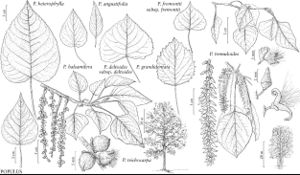Difference between revisions of "Populus fremontii"
Proc. Amer. Acad. Arts 10: 350. 1875.
imported>Volume Importer |
RevisionBot (talk | contribs) m (Bot: Adding category Revised Since Print) |
||
| Line 66: | Line 66: | ||
}}<!-- | }}<!-- | ||
| − | -->[[Category:Treatment]][[Category:Populus]] | + | --> |
| + | |||
| + | [[Category:Treatment]] | ||
| + | [[Category:Populus]] | ||
| + | [[Category:Revised Since Print]] | ||
Latest revision as of 17:15, 6 November 2020
Plants to 30 m, 37 dm diam.; strongly heterophyllous, (often 2 or more trunks near base). Bark pale tan, deeply furrowed. Branchlets tannish brown, becoming paler tan to bone- white by third year, round, 1–3(–5) mm diam., slender to coarse, glabrous, glabrate, or sparsely to densely hairy, (yellowish). Winter buds yellow-brown, usually densely stiffly hairy, resinous (resin yellow); terminal buds (4–)7–11(–14) mm; flowering buds separated on branchlets, (5–)11–18(–22) mm. Leaves: petiole distally flattened at right angle to plane of blade, 1–6(–9) cm, 3/5–3/4 blade length; blade rhombic-ovate to broadly triangular-ovate, (1.5–)4–8(–14) × (1.5–)3–8(–11) cm, w/l = 3/5–1/1, base cuneate to truncate or cordate, basilaminar glands 0, margins translucent, ciliate, apex short- to long-acuminate, surfaces yellowish green, resin stains not evident, glabrous or densely hairy; preformed blade margins coarsely crenate-serrate midblade, teeth 3–10(–15) on each side (graded, rounded), sinuses (0.2–)0.5–4(–5.5) mm deep; neoformed blade margins finely crenate-serrate much of margin, teeth (10–)20–30(–45) on each side, sinuses 0.1–1 mm deep. Catkins loosely (10–)15–25(–35)-flowered, (3–)4.5–10(–14 in fruit) cm; floral bract apex deeply cut, not ciliate. Pedicels 1–4(–5.5 in fruit) mm. Flowers: discs broadly cup-shaped, not obviously oblique, entire, (2.5–)4–7(–9) mm diam.; stamens (30–)40–60(–70); anthers truncate; ovary 2–4-carpelled, spherical; stigmas 2–4, flat, platelike, expanded. Capsules spherical, (5–)6–11 mm, glabrous, 2–4-valved. Seeds 9–15(–25) per placenta. 2n = 38.
Distribution

Ariz., Calif., Idaho, N.Mex., Nev., Tex., Utah, n Mexico.
Discussion
Subspecies 2 (2 in the flora).
Populus fremontii hybridizes with P. deltoides subsp. wislizeni where they come in contact in the Colorado Plateau region and trans-Pecos Texas. Hybrids have longer pedicels and narrower discs than does P. fremontii, and less densely hairy twigs in regions where P. fremontii is densely pubescent. It also hybridizes with the two members of sect. Tacamahaca with which it overlaps, P. trichocarpa (P. ×parryi Sargent), and P. angustifolia (P. ×hinckleyana Correll) (synonyms P. ×acuminata Rydberg nothomorph rehderi Sargent and P. ×intercurrens S. Goodrich & S. L. Welsh). Both hybrids have smaller, more numerous teeth on preformed leaves than does P. fremontii, with blades clearly paler abaxially than adaxially, and buds with reddish resin (J. E. Eckenwalder 1984). Preformed leaves are broadly ovate to heart-shaped in P. ×parryi (Eckenwalder 1984b) and usually ovate in P. ×hinckleyana; trees from the type locality in the Davis Mountains, Texas, had round leaves (D. S. Correll 1960). They could be distinguished from P. ×parryi by their smaller leaf blades and hairy petioles. Trees of P. ×parryi have been found in Mohave County, Arizona, east of the present range of P. trichocarpa (Eckenwalder 1992).
Populus ×inopina Eckenwalder is a hybrid between P. fremontii and P. nigra known only from the type locality along Coyote Creek, San Jose, California, where P. nigra was the seed parent (J. E. Eckenwalder 1982). Trees of the same parentage were produced artificially by A. B. Stout and E. J. Schreiner (1933); none appears to have survived. They differ from P. nigra in broader habit, twigs thicker, buds thicker and less red, broader and more cordate leaves with larger teeth, and more numerous stamens. They differ from P. fremontii in narrower habit, twigs more orange, buds without a green cast, longer leaf apices, more numerous teeth, and fewer stamens. If pistillate trees occur, they would be expected to have 2 or 3 carpels and discs 3–5 mm diam., both intermediate between those of the parents.
Selected References
None.
Key
| 1 | Neoformed blade: usually about as wide as long, rarely wider, bases truncate or cordate, apices short-acuminate; branchlets glabrous or glabrate to densely hairy. | Populus fremontii subsp. fremontii |
| 1 | Neoformed blade: longer than wide, bases cuneate or truncate, apices long-acuminate; branchlets usually densely hairy. | Populus fremontii subsp. mesetae |
